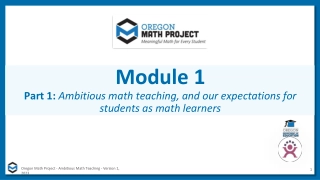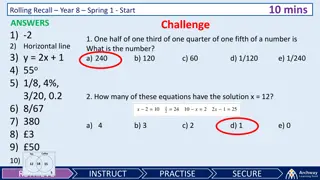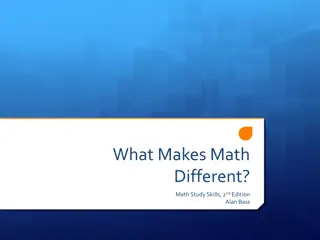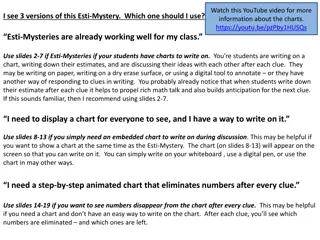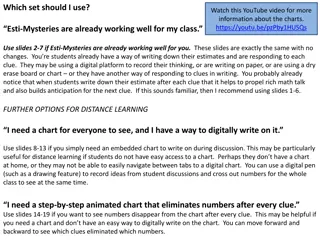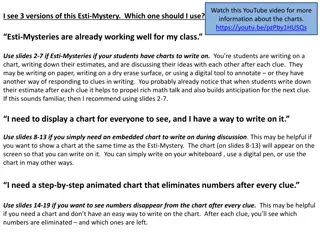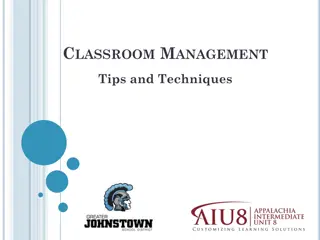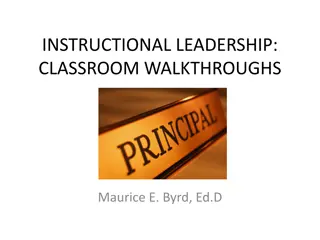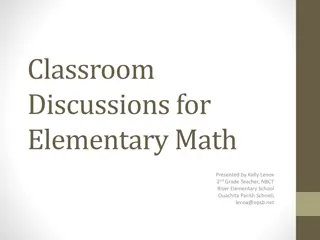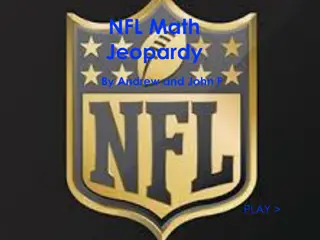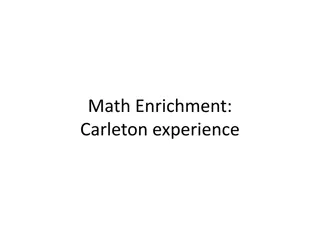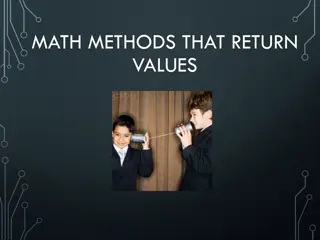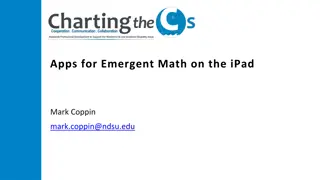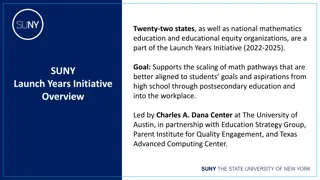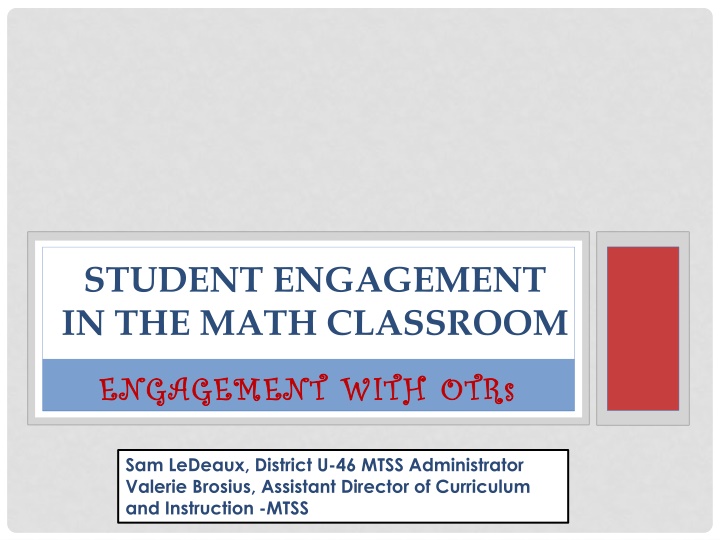
High-Performing High Schools: Indicators and Strategies
Explore the impact of Opportunities to Respond (OTRs) on student engagement and academic performance in the math classroom. Learn about the importance of OTRs, their benefits, and how they lead to improved instructional outcomes. Discover key strategies to actively engage learners and enhance their math learning experience.
Download Presentation

Please find below an Image/Link to download the presentation.
The content on the website is provided AS IS for your information and personal use only. It may not be sold, licensed, or shared on other websites without obtaining consent from the author. If you encounter any issues during the download, it is possible that the publisher has removed the file from their server.
You are allowed to download the files provided on this website for personal or commercial use, subject to the condition that they are used lawfully. All files are the property of their respective owners.
The content on the website is provided AS IS for your information and personal use only. It may not be sold, licensed, or shared on other websites without obtaining consent from the author.
E N D
Presentation Transcript
STUDENT ENGAGEMENT IN THE MATH CLASSROOM ENGAGEMENT WITH ENGAGEMENT WITH OTR OTRs s Sam LeDeaux, District U-46 MTSS Administrator Valerie Brosius, Assistant Director of Curriculum and Instruction -MTSS
OUTCOMES FOR TODAY Understand the impact of opportunities to respond (OTRs) on student engagement and outcomes Explicitly apply strategies to actively engage learners in math instruction
OTRs.WHAT ARE THEY? The number of times the teacher provides academic requests that require students to actively respond (Miller, 2009; Sprick, Knight, Reinke, & McKale, 2006) A teacher behavior that prompts or solicits a student response (Simonsen et al., 2008) Result in positive behavioral and academic outcomes Allows teacher insight
OTRsWHY DO THEM? High rates of OTRs lead to improved academic performance Student Engagement Academic Performance Effective Instruction
OTRsWHY DO THEM? Increases student engagement with instruction Allows for high rates of positive, specific feedback related to behavior Limits time for engaging in inappropriate behavior Results in more effective use of instructional time
DID YOU KNOW??? If OTRs were used instead of hand raising for just 30 minutes per day each student would make more than 3,700 additional academic responses during the school year.
CHANGE IT UP 7 MINUTES!
NINE INDICATORS OF HIGH-PERFORMING HIGH SCHOOLS A clear and shared focus. High standards and expectations for all students Effective school leadership (create school culture conducive to student learning) High levels of collaboration and communication Curriculum, instruction and assessments aligned with state standards Frequent monitoring of learning and teaching Focused professional development A supportive learning environment High levels of family and community involvement Office of the Superintendent of Public Instruction 2007
OTRSWE CAN USE THEM FOR: A quick formative assessment to guide teaching/lesson direction Provides teacher information on student understanding/thought process Allows teacher to correct errors in knowledge/understanding Evidence of gains in Reading and Math (e.g. mastery, rate, etc.)
OTRsVERBAL vs. NON-VERBAL Verbal Non-Verbal Involves action Orally Answering a question Writing Sharing thoughts Performing an action Summarizing Moving about the room No verbalization Repeating
OTRsINDIVIDUAL vs. GROUP Individual Group Allows teacher to know what EACH student thinks; targeted Provides ALL students the opportunity to answer without risk ; engages everyone
OTRsOn-the-spots Take the pulse of the class as a whole Quickly gauges depth of student understanding Requires little or no advanced preparation Think Pair Share Quick-Writes Thumbs Up When Ready/Processing Card Thumb Up/Down Vote Let s learn about these then practice
OTRsOn-the-spots Think Pair Share 1. Students reflect on question/prompt (30 seconds to formulate response) 2. Students pair up/turn to partner 3. Ask them to discuss responses Note: To avoid repeating directions, use Pair/Shares as simple review of procedural directions
OTRsOn-the-spots Quick Writes 1. Teacher selects prompt 2. Give students specified amount of time to collect thoughts and jot down response (3-5 minutes) 3. Follow up with: Pair/Share, Networking session, White board splash Note: To ensure higher order thinking, ask questions with phrases like in what ways how might things be different if why is this important how does this relate to our lives?
OTRsLETS DO SOME On-the-Spot Strategy Attention Please Pause and Apply 1 Minute
OTRsHold-Up Cards Letter Card Hold-Up Yes / No Hold-Up True/Not True Hold-Up 1. Ask students to think about/discuss responses to set of prepared questions 2. Have students Pair/Share or confer in small groups 3. Hold up cards when prompted 4. Select students to share their groups rationale Let s learn about these then practice
QUICK CHORAL RESPONSE Which number is greater? A. 44.678 B. -44.678 C. -54.342 D. 49.998
QUICK CHORAL RESPONSE Are these ratios equivalent? 568 773 639 877
QUICK CHORAL RESPONSE Do these ratios form a proportion? 106 to 530 and 128 to 654
OTRs Movement The more we study the cerebellum, the more we realize that movement is inescapably linked to learning and memory. Higher concentration of oxygen in the blood enhanced cognitive performance Sousa, 2006 Appointment Agendas Let s learn more about these and practice . Three 3 s in a Row
OTRsMovement Three 3 s in a Row 1. Prepare 9 questions based on content in a 3 by 3 template) 2. Students walk around room asking a peer to explain only 1 answer 3. Student summarizes peer s responses 4. Repeat 5. Share out as class Note: Do not allow students to write in others template avoid the pass the paper game
OTRsLETS DO SOME Movement Strategy Attention Please Pause and Apply 1 Minute
OTRsMovement Appointment Agenda: Provides students opportunity to respond and interact with a variety if classmates in a given day. 1. Provide every student with an Appointment Agenda template. 2. Ask them to walk around the room at the start of the day and sign up classmates for different times of the day. Both partners select a time that is open and write in their name.
APPOINTMENT AGENDAS CLOCK APPOINTMENTS On the hour hour hour hour
APPOINTMENT AGENDAS Time 8:45 8:55 9:05 9:15 9:25 You have an appointment with .
ACADEMIC LEARNING TIME IS the time that students are directly engaged in meaningful activities that are related to curriculum sequence and have successful outcomes
FOR MONDAY Think about what you have heard and practiced today. How can these engagement techniques be explicitly used? ? ? What can be (easily) implemented into your own classroom/setting?
INCREASING STUDENT ENGAGEMENT Instructional Strategy to Implement Brief description: What is it? An example of this strategy Benefits of using this strategy How can I use this in my class? Choral Response Partner Response Response Cards Whole Brain Teaching The strategy I will try first is .

